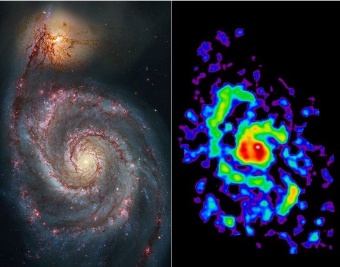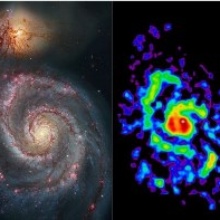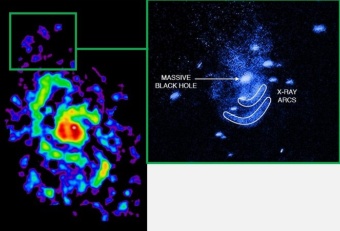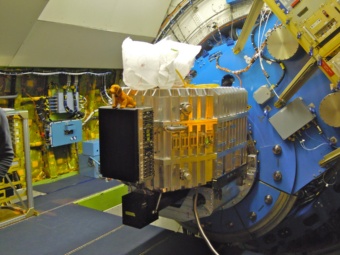-

Die Whirlpoolgalaxie M51 und ihr Begleiter M51b aufgenommen mit
dem Hubbel-Weltraumteleskop (links; Image Copyright: NASA, Hubble
Heritage Team, (STScI/AURA), ESA, S. Beckwith (STScI)) und mit dem
Ferninfrarotspektrometer FIFI-LS (@[CII]158μm-Linie) an Bord
von SOFIA (rechts; Copyright: J.L. Pineda et al.; C. Fischer /DSI).
Young, hot stars heat up their environment and thus also their birthplace itself. For more stars to form, this excess heat energy must be dissipated. Astronomers now know how this cooling works: So, for instance, the UV radiation of the young, hot stars ionizes the available neutral carbon - so one electron of each carbon atom is released - and in addition transferring it into an excited, so-called fine structure state through collisions. Subsequently, the energy supplied by this process is removed very efficiently by emission via the so-called fine-structure line [CII] at 158 μm. Thus, the strength of the [CII] 158 μm line is a direct measure of the energy or the number of young, hot stars, and thus the star formation rate in an area.
With the Stuttgart far infrared spectrometer FIFI-LS (The Far Infrared Field-Imaging Line Spectrometer) onboard of SOFIA, a team of scientists, led by Jorge Pineda of JPL in Pasadena now obtained a complete map of this [CII] 158 μm line of the so-called Whirlpool galaxy (M51) and its companion M51b. M51 itself is a large spiral galaxy about 30 million light-years away in the Hounds constellation. It is characterized by intense star formation, probably caused by the tidal interaction with M51b. With the current FIFI-LS data, covering an area of 10 x 6 arcminutes, astronomers can now accurately measure the intensity of the [CII] 158 μm in the center of M51, in its spiral arms, the areas in between, and in the companion galaxy M51b.
In the whirlpool galaxy itself, the observed data match expectations. Other star formation indicators, such as the total infrared luminosity, indicate, similar to the [CII] 158 μm line strenth, a high star formation rate in the center of M51 and in its spiral arms. The companion galaxy M51b, however, shows a strong deficit in the [CII] 158 μm intensity, thus suggesting a much lower star formation rate than, for example, the measurements of the total infrared luminosity
Other studies indicate that the stars of M51b are on average at least 10 billion years old. So,
the galaxy has already passed its most intense phase of star formation and hence it is low now and
in agreement with the weak [CII] 158 μm line. On the other hand, M51b is suspected to harbor an
Active Galactic Nucleus (AGN), responsible for a large amount of X-rays coming from the center of
the galaxy. This highly-energetic radiation can increase the temperature of the dust present, and
thus leading to a stronger total infrared luminosity, which would lead to inference of an
incorrectly, overestimated star formation rate.
"However, also the measured strength of the [CII] 158 μm line can be distorted by other
influences such as shock fronts with high densities and temperatures, leading to inaccurate
results," says Christian Fischer from the German SOFIA Institute of the University of Stuttgart,
who also belongs to the team around Pineda.
Ultra-Luminous Infrared Galaxies (ULIRGs), for example, also show a deficit of [CII] 158 μm
compared to the total infrared brightness. They produce 100 to 1000 times higher intensities in the
infrared than our own Milky Way Galaxy, and are considered
the
primary star-forming galaxies of the local universe. Their extreme luminosity is caused by
galaxy collisions, that are always accompanied by high star formation rates as well.
The [CII] 158 μm deficit in ULIRGs is therefore real and may be caused by the shock fronts in
those massive clouds of gas, that as well always occur in violent galactic collisions. "The exact
opposite behavior of the [CII] 158 μm line in M51b to the ULIRGs makes our result so exciting,"
says Christian Fischer.
"SOFIA has been able to capture the large map in a fraction of the time required by the Herschel Space Telescope," Alfred Krabbe explains, who completed construction of the FIFI-LS instrument at the Institute of Space Systems at the University of Stuttgart. "But Herschel is now out of service, so only with the fast FIFI-LS instrument on board SOFIA it was possible to detect the faint [CII] 158 μm line in M51b in reasonable time.” Further SOFIA data obtained by GREAT, the German REceiver for Astronomy at Terahertz Frequencies, should provide detailed information about the velocity fields in the whirlpool galaxy and its companion M51b in addition.
Further scientific results using FIFI-LS and other instruments on board of SOFIA have recently been published in a special issue of the prestigious „Astrophysical Journal Letters" (ApJL) . In there, new clues as to how stars form and how galaxies evolve are revealed. It also reports how astronomers made progress in their quest to discover life on Jupiter’s moon Europa. The instruments on-board SOFIA are sensitive to different wavelength ranges of infrared light, giving astronomers insight into the composition and development of our universe.
Weitere Links
- A SOFIA Survey of [C II] in the Galaxy M51. I. [C II] as a Tracer of Star Formation; Jorge L. Pineda, Christian Fischer, Maria Kapala, Jürgen Stutzki, Christof Buchbender, et al.; 2018 ApJL 869 L30
- Focus on New Results from SOFIA, William Reach (SOFIA Science Center, NASA Ames Research Center)
- SOFIA Uncovers Clues to the Evolution of Universe and Search for Life (USRA News)
- SOFIA Uncovers Clues to the Evolution of Universe and Search for Life (NASA News)
Weitere SOFIA Links
| Contact | Dörte Mehlert, Email: mehlert@dsi.uni-stuttgart.de; Tel.:0711 - 685-69632 |
|---|




